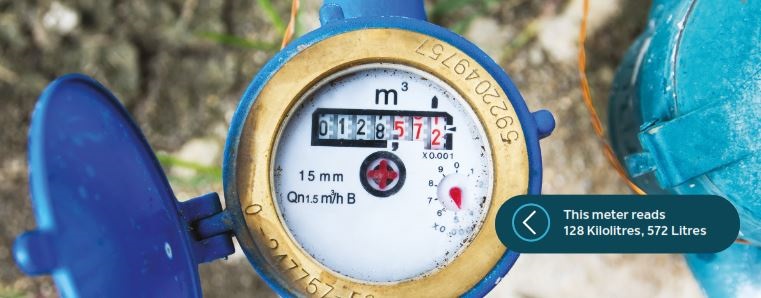Your water meter explained
Water Meter Location
It's important to understand what responsibilities you have as a property owner when it comes to your water meter.
Water meters are installed on the property boundary, where practical that allows access to the meter for reading, replacing and repairing the meter. For units, rural or commercial properties, this may not be the case. The location of the water meter is at Council’s discretion and must only be installed by Council's Network Team or Council approved contractors.
Connecting to Councils water supply without Council approval is not permitted.
Ownership and Responsibility
As the property owner, you own and are responsible for maintaining and repairing all pipes, taps, drains and backflow prevention devices within your property. Council is responsible for everything up to and including the water meter. The diagram below shows where Council’s responsibility ends, and the property owner's responsibility begins.

Reading your water meter
Your water meter is read by Council contracted meter readers three times a year in order for your water account to be calculated.
Council use metric water meters which read in kilolitres. All meters have dials showing the amount of water that has passed through the meter since it was installed. The counter dials are usually coloured black and red ranging from six to nine dials.

The black numbers represent kilolitres (a thousand litres). This reading is used to calculate your bill. The dial above would be read as 462 kilolitres.
Customers are responsible for all the water that has passed through the water meter. Reading your water meter regularly can help manage your water usage and help identify water leaks. Finding a problem early can reduce the impact on your water usage account.

Checking for leaks
Reading your water meter can help detect possible leaks. To check your water meter for leaks:
1. Before you go to bed, after brushing your teeth and using the toilet. Turn off all taps and water-using appliances at your property.
2. Take a photo or write down your water meter reading.
3. In the morning, check your meter reading again before anyone uses any water including flushing the toilet.
If no one has used any water overnight and the reading has changed, then you know there is a leak. Contact a licensed plumber to investigate, locate and repair the leak.
For a simple check turn off all water using appliances and taps on the property (don’t turn off the tap or stop valve at the meter) and look to see if the meter dials (red numbers) are still turning.
The red numbers can also help monitor how much water your average shower, laundry cycle or dishwasher uses. Just make sure you turn off all other water using appliances to give you an accurate reading.
Accessing your water meter
Council requires access to water meters for various reasons including reading the meter and repair or replacement. It is important a water meter is not:
- Buried or with insufficient clearance to pipes
- Encased in concrete
- Behind a locked gate or door
- Obscured by an overgrown garden
- In the same proximity as a dog.
Find out more in Council’s Water and Sewer Group Customer Service Plan.
Water Meter Accuracy Testing
If you feel that your meter isn't recording accurately, you can contact Council to request that your water meter be tested. You will be responsible for pre-payment of this test, but if the meter is found to be inaccurate, we will refund you this fee.
Once completed, we will advise you of the meter testing results and make available a written report on your request.